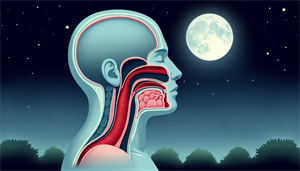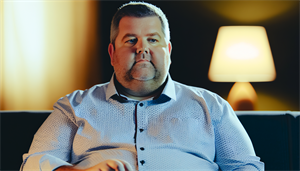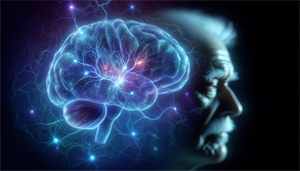Can trauma cause sleep apnea? The intersection of trauma, particularly PTSD, and sleep disorders has sparked research due to their significant overlap.
Scientific studies show a correlation between PTSD and a higher incidence of sleep apnea, suggesting that traumatic experiences might influence sleep health.
This article investigates how these two conditions may intersect, without committing to the unfounded cause-and-effect conclusions.
Key Takeaways
-
There is a significant connection between trauma, particularly PTSD, and sleep disorders like obstructive sleep apnea, with a high prevalence of sleep disordered breathing among individuals with PTSD.
-
Obstructive sleep apnea is characterized by recurrent pauses in breathing during sleep and can lead to multiple health complications if untreated; the primary treatment is CPAP therapy, among other alternatives.
-
Effective management of sleep apnea and PTSD often requires a combination of treatments such as CPAP therapy, psychological therapies (like CBT and EMDR), and medication, along with lifestyle modifications that can significantly improve both sleep quality and mental health.
Exploring the Relationship Between Trauma and Sleep Apnea

There’s a growing interest in the clinical and research fields about the connection between trauma, specifically post-traumatic stress disorder (PTSD), and sleep disorders, like obstructive sleep apnea. Studies indicate a high prevalence of sleep disordered breathing, such as obstructive sleep apnea, among individuals with PTSD, ranging from 12 to 90%. The coexistence of these two conditions often exacerbates each other’s symptoms, although a direct causation between trauma and sleep apnea has not been established.
Sleep apnea can interfere with REM sleep, where fear extinction and processing of nightmares take place. This disturbance is especially crucial for individuals with PTSD, as it disrupts the fear extinction process. This disruption could ultimately lead to exacerbated PTSD symptoms. Conversely, addressing both PTSD and sleep apnea concurrently in sleep medicine treatment can enhance an individual’s overall well-being and quality of life, as these conditions are interconnected. For instance, it has been demonstrated that adherence to Continuous Positive Airway Pressure (CPAP) therapy for OSA can lead to notable enhancements in PTSD symptoms.
The complex connection between PTSD and sleep apnea underscores the need for simultaneous understanding and management of these conditions. This involves recognizing the symptoms, understanding the risk factors, and exploring suitable treatment options. Moreover, it demands a holistic approach that not only focuses on medical treatment but also emphasizes lifestyle modifications to bolster mental health and sleep quality.
The Impact of PTSD on Sleep
Nightmares and frequent awakenings are common sleep disturbances that can be triggered by PTSD. In fact, the occurrence of these sleep disturbances is notably high among individuals with PTSD, with 70–90% of patients reporting such issues and 35–61% experiencing symptoms of insomnia. The sleep cycle in individuals with PTSD is significantly affected, characterized by increased light sleep, reduced slow-wave sleep, and higher REM density. These alterations disrupt the brain’s capacity to handle memories and emotions, thereby hindering the recovery process following a traumatic event. Obstructive sleep apnea syndrome can further exacerbate these sleep disturbances.
The risk of developing obstructive sleep apnea (OSA) is heightened by the presence of PTSD. Furthermore, untreated sleep apnea can cause more frequent awakenings, potentially leading to more intense and frequent nightmares for individuals with PTSD. Therefore, it’s crucial to recognize the impact of PTSD on sleep and seek timely and appropriate treatment to mitigate these disturbances and improve sleep quality.
The Bidirectional Connection
PTSD and sleep apnea share a bidirectional relationship, where each condition potentially escalates the risk of the other, creating a vicious cycle of sleep disturbances and intensifying symptoms. Research indicates that there is a bidirectional relationship between PTSD and disturbed sleep, such as sleep apnea (OSA) and/or insomnia, with each being predictive of the development of the other. Furthermore, the prevalence of sleep apnea in patients with traumatic stress disorder PTSD is higher than in the general population, indicating a significant connection.
Evidence suggests that managing obstructive sleep apnea with CPAP therapy can lead to significant improvements in PTSD symptoms. Studies have indicated that veterans with coexisting PTSD and OSA may experience symptom improvement and up to a 50% reduction in PTSD-related nightmares by using a CPAP machine. This highlights the potential benefits of treating sleep apnea in individuals with PTSD and underscores the importance of recognizing and addressing these interconnected conditions.
Understanding Obstructive Sleep Apnea

Recurrent pauses in breathing during sleep characterize obstructive sleep apnea, a common sleep disorder. It’s often associated with loud snoring, waking up feeling tired, headaches upon waking, dry or sore throat, difficulty in sleeping, and excessive daytime sleepiness, among other symptoms. The obstructive sleep apnea severity can vary among individuals, and if left untreated, sleep apnea can lead to various health complications, including heart disease, high blood pressure, stroke, and diabetes.
For obstructive sleep apnea, the primary treatment is Continuous Positive Airway Pressure (CPAP) therapy. It helps keep the airways open during sleep, improving breathing and reducing symptoms such as snoring and daytime fatigue. During CPAP therapy, the patient wears a mask connected to a machine through a hose. This is typically done while the patient is sleeping. The machine delivers a continuous stream of air that helps maintain open airways, thereby preventing the collapse that typically leads to apnea episodes. By maintaining open airways, CPAP therapy reduces snoring and instances of breathing interruptions associated with sleep apnea, leading to improved sleep quality.
However, if CPAP therapy proves ineffective, various alternative treatments are available. These include:
-
Other forms of positive airway pressure (PAP) therapies
-
Oral appliances
-
Surgical interventions
-
Medication
The choice of treatment largely depends on the severity of the condition and the patient’s comfort and preference, underscoring the importance of a personalized approach to treatment.
Risk Factors for Developing Sleep Apnea

Several factors contribute to an increased risk of developing sleep apnea. These include:
-
Obesity
-
Family history
-
Smoking
-
Alcohol use
-
Having a history of trauma or PTSD
Obesity contributes to the heightened risk of developing sleep apnea through fat deposition in the tissues surrounding the upper airway. This leads to a smaller airway and increased collapsibility, thereby contributing to the occurrence of apnea episodes. Additionally, fat deposits around the thorax reduce chest compliance and functional residual capacity, and may also increase oxygen demand.
Other factors such as family history and alcohol consumption also play a significant role. Individuals are at a higher risk of developing sleep apnea if they have a close family member with the condition, as obstructive sleep apnea is a genetically intricate disease that can be passed down through generations. Alcohol consumption can exacerbate airway obstruction in sleep apnea by inducing relaxation in the airway muscles and suppressing the brain’s regulation of breathing patterns.
Understanding these risk factors can help in the prevention and management of sleep apnea.
Treatment Approaches for Sleep Apnea and PTSD

A combination of therapies addressing both conditions is often the most effective treatment for sleep apnea and PTSD. Addressing PTSD can result in improved sleep quality, while managing OSA can contribute to enhancements in mood, overall quality of life, and other factors associated with PTSD.
Some common therapies for sleep apnea and PTSD include:
-
Continuous Positive Airway Pressure (CPAP) therapy: This treatment for obstructive sleep apnea entails the use of a machine to administer continuous pressurized air through a mask, thereby preventing airway collapse during sleep. Notably, consistent CPAP therapy has been found to alleviate PTSD symptoms such as anxiety, depression, and nightmares.
-
Cognitive Behavioral Therapy (CBT): This therapy focuses on identifying and changing negative thought patterns and behaviors that contribute to sleep problems and PTSD symptoms.
-
Medications: Certain medications may be prescribed to help manage symptoms of both sleep apnea and PTSD.
By combining these therapies, individuals can effectively manage both conditions and improve their overall well-being.
The most effective treatment options for Obstructive Sleep Apnea (OSA) typically involve CPAP therapy and potentially nasal CPAP therapy. However, treating PTSD in patients with concurrent sleep disorders typically involves non-pharmacological interventions for insomnia and nightmares. Additionally, sedative antidepressants may be used to address PTSD-associated insomnia, and prazosin may be prescribed to treat sleep disturbances. In the field of clinical sleep medicine, these approaches are essential for managing obstructive sleep apnea and related sleep issues.
These treatment approaches underscore the importance of a comprehensive and integrated approach to managing sleep apnea and PTSD. Addressing both conditions concurrently can enhance treatment effectiveness and improve overall health outcomes. In addition to medical treatments, lifestyle modifications can also significantly contribute to managing these conditions and improving sleep and mental health.
Sleep Apnea Treatment Options
CPAP therapy is frequently the initial treatment approach in managing sleep apnea. It involves the use of a CPAP machine to administer pressurized air through a mask, which helps maintain open airways during sleep, thus reducing snoring and instances of breathing interruptions associated with sleep apnea.
Several lifestyle modifications are also recommended for managing sleep apnea, including:
-
Weight loss
-
Increased physical activity
-
Cessation of alcohol and smoking
-
Avoidance of specific medications
-
Altering sleep positions
Weight loss has been shown to have a significant positive impact on sleep apnea symptoms. Some benefits of weight loss include:
-
A reduction in body weight, even as little as 10%, can result in noticeable improvements
-
In some instances, substantial weight loss can effectively eliminate sleep apnea
-
Both medical and surgical weight loss interventions have demonstrated beneficial effects on the severity of sleep apnea and glycemic control
Thus, a combination of medical treatments and lifestyle modifications can significantly improve sleep apnea symptoms and enhance sleep quality.
PTSD Treatment Options
The foundation of PTSD treatment lies in psychological therapies. Primary treatment options for PTSD typically involve psychological therapies such as EMDR (Eye Movement Desensitisation Reprogramming) and CBT (Cognitive Behavioural Therapy). EMDR therapy has demonstrated high effectiveness in the treatment of PTSD, leading to improved diagnoses and reduced symptoms. CBT addresses PTSD by emphasizing the connections between thoughts, emotions, and actions, utilizing exposure therapy, cognitive restructuring, and skills training to modify negative thought processes and behaviors.
In addition to psychological therapies, certain medications have also shown effectiveness in managing posttraumatic stress disorder (PTSD) symptoms. For instance, Selective Serotonin Reuptake Inhibitors (SSRIs), including sertraline and paroxetine, are approved pharmacotherapy agents for managing PTSD. They are effective in reducing the core symptoms of PTSD and can enhance brain activation in areas responsible for processing emotions in individuals with PTSD.
The combination of psychological therapies and medication can provide comprehensive treatment for individuals with PTSD, helping them manage their symptoms and improve their quality of life.
Lifestyle Changes to Improve Sleep and Mental Health

For individuals with sleep apnea and PTSD, significant improvement in sleep quality and mental health can be achieved by implementing lifestyle changes. Some key changes to consider include:
-
Maintaining a healthy diet
-
Managing weight
-
Engaging in regular exercise
-
Practicing stress management techniques
-
Establishing a consistent sleep schedule
-
Creating a relaxing sleep environment
These measures not only have the potential to enhance sleep quality by alleviating sleep apnea symptoms but also play a role in facilitating the recovery process for individuals with PTSD.
Exercise also plays a significant role in managing both sleep apnea and PTSD. Regular exercise can improve sleep quality for individuals with sleep apnea, and aerobic exercise may offer mental health benefits as an effective treatment option for individuals with PTSD. Furthermore, decreasing or eliminating alcohol and caffeine can result in enhancements in both sleep and mental health conditions, as alcohol has the potential to worsen obstructive sleep apnea and disrupt sleep quality, whereas caffeine can heighten anxiety symptoms associated with PTSD.
In addition to diet and exercise, other lifestyle modifications can enhance mental health for individuals with mental disorders, such as PTSD. These include participation in support groups, adoption of mindfulness practices and yoga, and maintenance of a balanced diet. All these measures contribute to establishing a conducive environment for improved mental well-being.
By adopting these lifestyle changes, individuals with sleep apnea and PTSD can significantly improve their sleep quality and mental health, thereby enhancing their overall quality of life.
Sleep Hygiene Tips
Significant improvements in sleep quality and overall well-being can be achieved through the adoption of good sleep hygiene practices. Key components of an effective bedtime routine may include creating a tranquil environment and minimizing electronic device usage to promote better quality sleep. Optimizing the sleep environment involves minimizing noise and light exposure, maintaining a suitable room temperature, and utilizing comfortable mattresses and bedding.
Another essential aspect of sleep hygiene is maintaining a consistent sleep schedule. This helps regulate the body’s internal clock, leading to improved sleep quality and facilitating natural transitions into sleep and wakefulness. These sleep hygiene tips, along with other lifestyle modifications, can significantly improve sleep quality and in turn, help manage sleep apnea and PTSD symptoms.
Stress Management Techniques
Stress management techniques significantly contribute to managing PTSD and improving sleep quality. Effective mindfulness meditation techniques for stress management and improved sleep in trauma patients encompass:
-
Deep breathing
-
Body scanning
-
Meditative walking
-
Other focused activities like swimming or mindful drinking
Deep breathing exercises stimulate the parasympathetic nervous system, leading to a sense of relaxation and calmness. This helps in achieving a balance between the mind and body and in detaching from intrusive thoughts.
Regular physical activity, particularly aerobic exercise, offers benefits to individuals with PTSD by reducing symptom severity, improving coping, lowering stress hormones, and enhancing the production of endorphins, which contributes to better mental health and stress management. Aerobic workouts, such as running, dancing, and boxing, along with brisk walking, have been proven to effectively manage stress by reducing stress hormones and increasing the production of endorphins, the body’s natural mood elevators.
By incorporating these stress management techniques, individuals with PTSD and sleep apnea can significantly improve their mental health and sleep quality.
Recognizing the Signs and Seeking Help
It’s vital to recognize the signs of sleep apnea and PTSD to seek suitable help and treatment. Acknowledging the symptoms of PTSD is essential to facilitate the pursuit of suitable assistance and treatment, given its severe and persistent nature, which can have a substantial impact on an individual’s overall well-being. Typical indicators of PTSD that individuals should be mindful of include re-experiencing trauma in flashbacks or recurrent dreams, avoiding reminders of the event, and feeling emotionally numb or detached.
PTSD symptoms are notably more intense and enduring in comparison to normal stress reactions, which typically decrease over time. PTSD entails re-experiencing a traumatic event through nightmares, flashbacks, or persistent thoughts about the event. Similarly, sleep apnea can result in decreased cognitive function, memory impairment, depressive symptoms, fatigue, reduced ability to focus, delayed reaction times, and daytime drowsiness, all of which can significantly impact an individual’s daily functioning.
Recognizing these signs and understanding the serious implications of untreated sleep apnea and PTSD is crucial. It’s only through recognition and understanding that individuals can seek the help they need and embark on their path towards recovery and improved health.
When to Consult a Doctor
Knowing when to seek medical advice is crucial. Common indicators of sleep apnea that necessitate a medical consultation include loud snoring, fatigue, daytime sleepiness, excessive tiredness, gasping for air during sleep, and waking up with a headache. It is advisable to seek consultation with a medical professional if you have a history of trauma or PTSD and are experiencing symptoms of sleep apnea, or if you have concerns regarding your mental health and the quality of your sleep.
Consulting a healthcare provider can ensure a proper diagnosis and appropriate treatment plan, thereby maximizing the chances of successful treatment. In addition to prescribing treatment and providing valuable advice, healthcare providers can also offer support and resources to help individuals navigate their journey towards recovery and improved health.
Summary
The relationship between trauma, particularly post-traumatic stress disorder (PTSD), and sleep disorders such as obstructive sleep apnea (OSA) is complex and significant. It’s crucial to recognize the impact of these conditions on each other and understand the necessity of addressing them simultaneously. Effective treatment often involves a combination of medical treatments and lifestyle modifications, with an emphasis on good sleep hygiene and stress management techniques.
Understanding the signs of sleep apnea and PTSD, acknowledging the risk factors, and being aware of the various treatment options can significantly improve the management of these conditions. It’s crucial to seek help when needed and remember that help is always available. With the right approach and support, individuals with sleep apnea and PTSD can significantly improve their sleep quality, mental health, and overall quality of life.
Frequently Asked Questions
How do I prove my sleep apnea is secondary to PTSD?
You can prove that your sleep apnea is secondary to PTSD by obtaining an independent medical opinion (IMO) from a doctor who can explain to the VA why they believe your condition was caused or aggravated by your PTSD. This will provide a persuasive argument for your case.
How long will it take to reverse damage from sleep apnea?
Treating sleep apnea with CPAP for just 12 months can almost entirely reverse damage done to white matter, improving sleep and symptoms while decreasing the risk for cognitive issues.
Can abuse cause sleep apnea?
Yes, abuse, particularly traumatic events, can lead to symptoms such as nightmares, flashbacks, and avoidance of triggers, which can also result in sleep disturbances such as obstructive sleep apnea.
How does PTSD impact sleep?
PTSD can lead to sleep disturbances such as nightmares and frequent awakenings, affecting the sleep cycle by increasing light sleep, reducing slow-wave sleep, and increasing REM density.
What are the treatment options for sleep apnea?
The main treatment for obstructive sleep apnea is Continuous Positive Airway Pressure (CPAP) therapy, but alternative options include other positive airway pressure therapies, oral appliances, surgery, and medication. It is important to consult with a healthcare professional to determine the best option for you.


